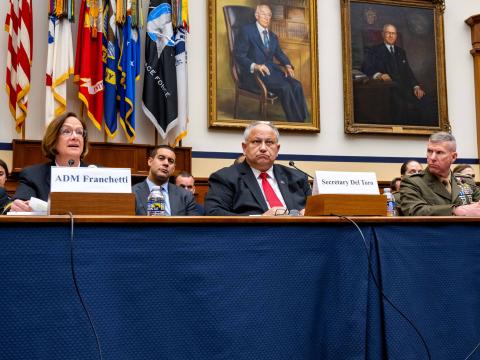IARPA Poised To Provide Four Mystery Drone Prototypes to Intelligence Community
In the coming weeks, Alexis Truitt, the Little Horned Owl (LHO) program manager at the Intelligence Advanced Research Projects Activity (IARPA), will recommend which intelligence agencies should receive Boeing-built prototypes from the program, which finished final testing and analysis in September.
Boeing beat out competitor Northrop Grumman in the final selection and will provide four prototypes. The LHO program began in 2018 with the intent of building ultra-quiet, mini-sized unmanned aircraft weighing 55 pounds or less and acoustic “footprint” prediction tools to allow operators to know where they can safely and quietly operate. They are expected to further enable critical intelligence and military missions.
“I’d like to, say before May, make my final recommendations to our director where those four prototypes will go for maximum impact for a variety of intelligence community missions. We have a list that’s continuing to grow, and we’re reaching out to those transition partners to see if what we built fits their needs,” Truitt said in a SIGNAL Media interview.
For operational security reasons, Truitt could not name the potential transition partners for the prototypical unmanned aerial vehicles (UAVs) or even say exactly how many are on the list. She only reported that it is more than “the number of prototypes that I have available,” but she also indicated it’s not too late for others to get on the list. “If anybody would like to reach out and learn more across the intelligence community and Department of Defense, if there’s an imminent need for a UAV, we would consider that.”
In a 2020 interview, IARPA director Catherine Marsh described the LHO program as one of the organization’s most classified. “If we are successful with the program results, that’s going to be a game changer for the intelligence community. That program is one of our more classified programs, so I can’t go into much more than that, but these tests are critical,” Marsh asserted. “One of the things you find with unmanned aerial vehicles is that you can hear them before you see them, so that’s an alert, and you don’t want an alert. I’m very excited about it.”
Truitt echoed the need to deploy quieter unmanned aircraft. “It’s getting harder and harder to conduct our intelligence community missions with UAVs, so we wanted to develop a vehicle that could not disturb humans on the ground. In order to do that, you have to learn how to change the acoustic energy from the vehicle,” she offered. “And how do you do that? It’s through changing the aircraft design, changing the output, and the combination of the system. We focus on quiet airframes, quiet propulsion systems, new ways to lift and control and the combinations of those.”
Asked whether she could quantify how much quieter the new systems are than existing platforms, Truitt said IARPA did measure the improvements in noise production. “So the general sense that I could speak to publicly is that we don’t want to disturb humans on the ground. We don’t want to create noise pollution. We had metrics related to being acoustically quiet, and we had those government facilities measure that quantitatively.”
In addition to operating quietly, the LHO prototypes are expected to have a flight radius of 30 miles and to spend no more than 30 minutes on station. The 55-pound weight limit includes a 10-pound payload of intelligence, surveillance and reconnaissance sensors, and the systems provide innovative mission control capabilities. “To have innovative mission control and then also being acoustically quiet, we felt that these metrics were scoped appropriately, where we could advance the research and development and really push the state of the art and invest in the research areas that perhaps are too risky for other government agencies to pursue.
Balancing the different requirements proved to be the biggest technological challenge. “The hardest challenge is with regard to creating an acoustically quiet airframe, under the scope, the physical limitations of the system. There’s a limitation to how you control the vehicle, and a combination of control, that endurance, the airframe design and the acoustics,” she explained. “So there’s a give-and-take, and these systems are coupled, and going through an iterative process to optimize the design, to meet the metrics, is a challenge.
Both Boeing and Northrop Grumman, she said, offered innovative designs. “Each team executed a methodical process in order to converge on a unique solution. In simple terms, I can’t just keep increasing the amount of batteries in the system and then not consider the center of gravity, the weight and how that could affect control.”
And even though Northrop Grumman was not ultimately chosen, their innovations could be adopted for future UAVs. “We don’t have any vehicles from them at the end of this program, but a lot of the innovative design and research that Northrop was able to achieve has informed, potentially, future UAV programs for the intelligence community.”

If anybody would like to reach out and learn more across the intelligence community and Department of Defense, if there’s an imminent need for a UAV, we would consider that.
Because of the program’s sensitivity, Truitt declined to name which system, or systems, Boeing offered for the program, and a Boeing spokesperson declined to comment. However, the LHO program page mentions only two systems that will be made available to the intelligence community, and Truitt said there will be four, so that suggests—purely speculatively—the possibility of different versions of one or two unmanned platforms.
Truitt also had to remain vague about some of the prototypical capabilities, but both the Great Horned Owl program and the Robust Energy Sources for Intelligence Logistics in Extreme, Novel and Challenging Environments (RESILIENCE) program are considered predecessors to LHO. The former developed a hybrid electric propulsion system to quietly generate electrical power from specifically gasoline or diesel and enable purely electrically driven, quiet flight. “We were able to demonstrate the art of the possible for an electrically driven UAV. Understanding that we could quietly generate electric power was a feat in itself, and lessons learned from that Great Horned Owl have informed the scope for smaller UAVs in this LHO system.”
The latter focused on improving battery technology for both longer flights. “The battery capabilities didn’t seem to be up to par prior to launching the program, and so a lot of the requirements for UAVs informed the IARPA RESILIENCE program, which is a battery program, so there’s some connection there,” Truitt said.
The program manager reported that the systems have proven rugged enough for austere locations. “They are proven through our flight testing campaigns at government facilities. We had our transition partners come out and learn how to control the vehicles and to answer [their] questions about the design. They’re quite durable, I can tell you firsthand. They’re able to be deployed in remote locations, and they’re pretty mobile.”
Ultimately, it may not be just the intelligence community that benefits from the design innovations. “I can envision some of these technologies supporting the design of larger commercial aircraft in the future. UAVs are ubiquitous in everyday life from the Amazons trying to deliver packages to Domino’s trying to drop pizza at your front door. In general, I could see how some of the technology developed here could benefit worldwide,” Truitt said.




